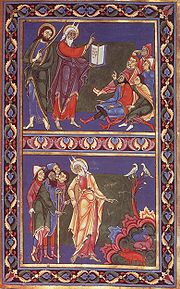
Master Hugo
Encyclopedia

Romanesque art
Romanesque art refers to the art of Western Europe from approximately 1000 AD to the rise of the Gothic style in the 13th century, or later, depending on region. The preceding period is increasingly known as the Pre-Romanesque...
lay artist. His documented career at Bury St Edmunds Abbey spans from before 1136 to after 1148. He is most famous for illuminating the first volume of the Bury Bible, which "have led to a general acknowledgement of Master Hugo as the gifted innovator of the main line of English Romanesque art
Romanesque art
Romanesque art refers to the art of Western Europe from approximately 1000 AD to the rise of the Gothic style in the 13th century, or later, depending on region. The preceding period is increasingly known as the Pre-Romanesque...
". This was made for the Abbey in about 1135, and is now in the Parker Library of Corpus Christi College
Corpus Christi College, Cambridge
Corpus Christi College is a constituent college of the University of Cambridge. It is notable as the only college founded by Cambridge townspeople: it was established in 1352 by the Guilds of Corpus Christi and the Blessed Virgin Mary...
, Cambridge
Cambridge
The city of Cambridge is a university town and the administrative centre of the county of Cambridgeshire, England. It lies in East Anglia about north of London. Cambridge is at the heart of the high-technology centre known as Silicon Fen – a play on Silicon Valley and the fens surrounding the...
; it is not known whether he illuminated the second volume, of which only a small fragment is known to survive, now in a private collection in the USA. He is also recorded as making bronze
Bronze
Bronze is a metal alloy consisting primarily of copper, usually with tin as the main additive. It is hard and brittle, and it was particularly significant in antiquity, so much so that the Bronze Age was named after the metal...
doors for the western entry of the Abbey church, a great bell and a carved crucifix
Crucifix
A crucifix is an independent image of Jesus on the cross with a representation of Jesus' body, referred to in English as the corpus , as distinct from a cross with no body....
with figures of Mary
Mary (mother of Jesus)
Mary , commonly referred to as "Saint Mary", "Mother Mary", the "Virgin Mary", the "Blessed Virgin Mary", or "Mary, Mother of God", was a Jewish woman of Nazareth in Galilee...
and Saint John
John the Evangelist
Saint John the Evangelist is the conventional name for the author of the Gospel of John...
, for the Monk's Choir (probably a rood
Rood
A rood is a cross or crucifix, especially a large one in a church; a large sculpture or sometimes painting of the crucifixion of Jesus.Rood is an archaic word for pole, from Old English rōd "pole", specifically "cross", from Proto-Germanic *rodo, cognate to Old Saxon rōda, Old High German ruoda...
). He has been credited with having made the ivory Cloisters Cross
Cloisters Cross
The Cloisters Cross, also referred to as the Bury St. Edmunds Cross, is an unusually complex 12th century ivory Romanesque altar cross in The Cloisters, part of the Metropolitan Museum of Art in New York. The cross is carved from walrus ivory and measures 22 5/8 x 14 1/4 in...
(or "Bury St. Edmunds Cross"), now at The Cloisters
The Cloisters
The Cloisters is a museum located in Fort Tryon Park, New York City. The building, which is a branch of the Metropolitan Museum of Art, was reconstructed in the 1930s from the architectural elements of several European medieval abbeys...
, New York, but this is disputed; there is no certain evidence to suggest that the cross was even made in England, although this is accepted by most scholars, and other places of origin such as Germany have been proposed.
Further reading
- ‘Gesta sacristarum’, Memorials of St Edmund's Abbey, ed. T. Arnold, 2, Rolls Series, 96 (1892), 289–96
- C. M. Kauffmann, ‘The Bury Bible’, Journal of the Warburg and Courtauld Institutes, 29 (1966), 60–81
- R. M. Thomson, ‘Early Romanesque book-illustration in England: the dates of the Pierpont Morgan Vitae sancti Edmundi and the Bury Bible’, Viator, 2 (1971), 211–25
- R. M. Thomson, ‘The date of the Bury Bible reexamined’, Viator, 6 (1975), 51–8
- Thomas Hoving, King of the Confessors. Simon & Schuster. New York, New York: 1981.
- C. R. Dodwell, The pictorial arts of the West, 800–1200 (1993), 341–7
- Elizabeth C. Parker & Charles T. Little, The Cloisters Cross. The Metropolitan Museum of Art. New York, N.Y.: 1994.
- T. A. Heslop, ‘The production and artistry of the Bury Bible’, Bury St Edmunds: medieval art, architecture, archaeology, and economy, ed. A. Gransden (1998), 172–85

